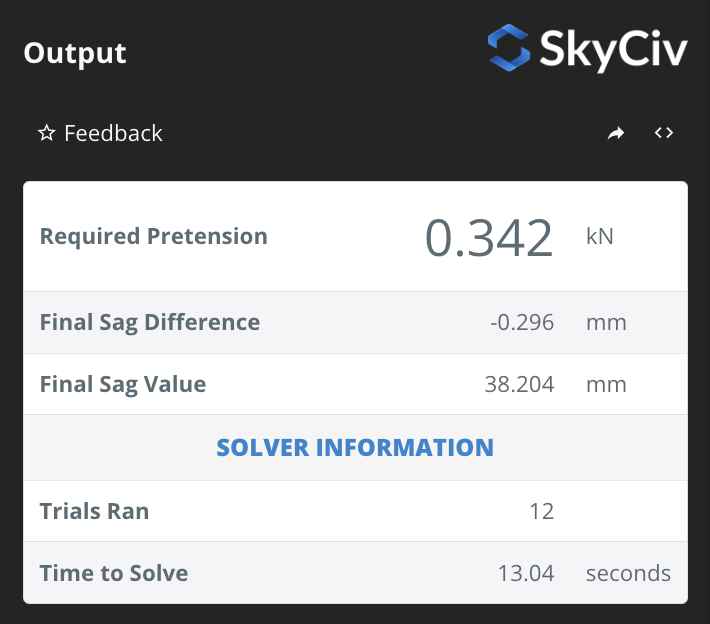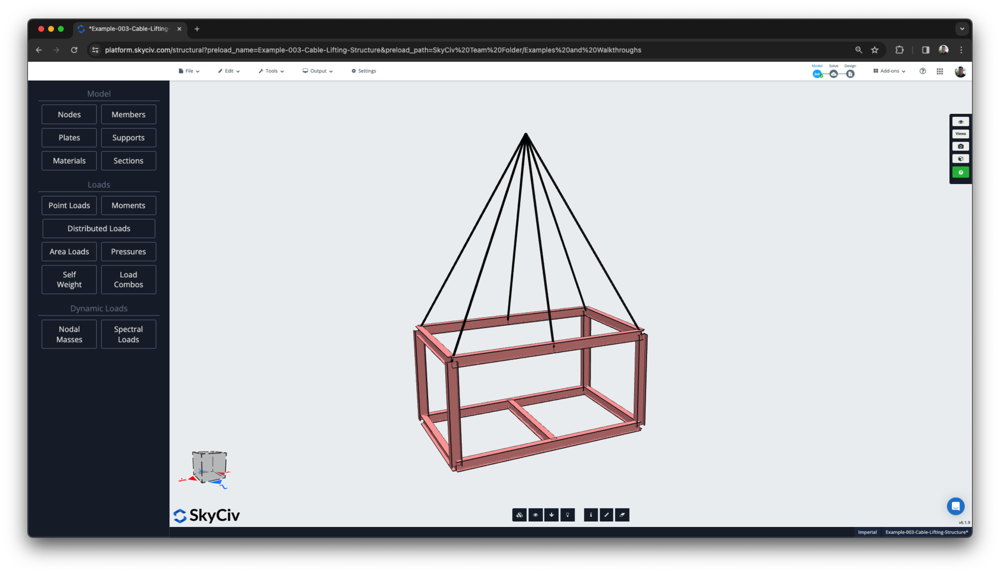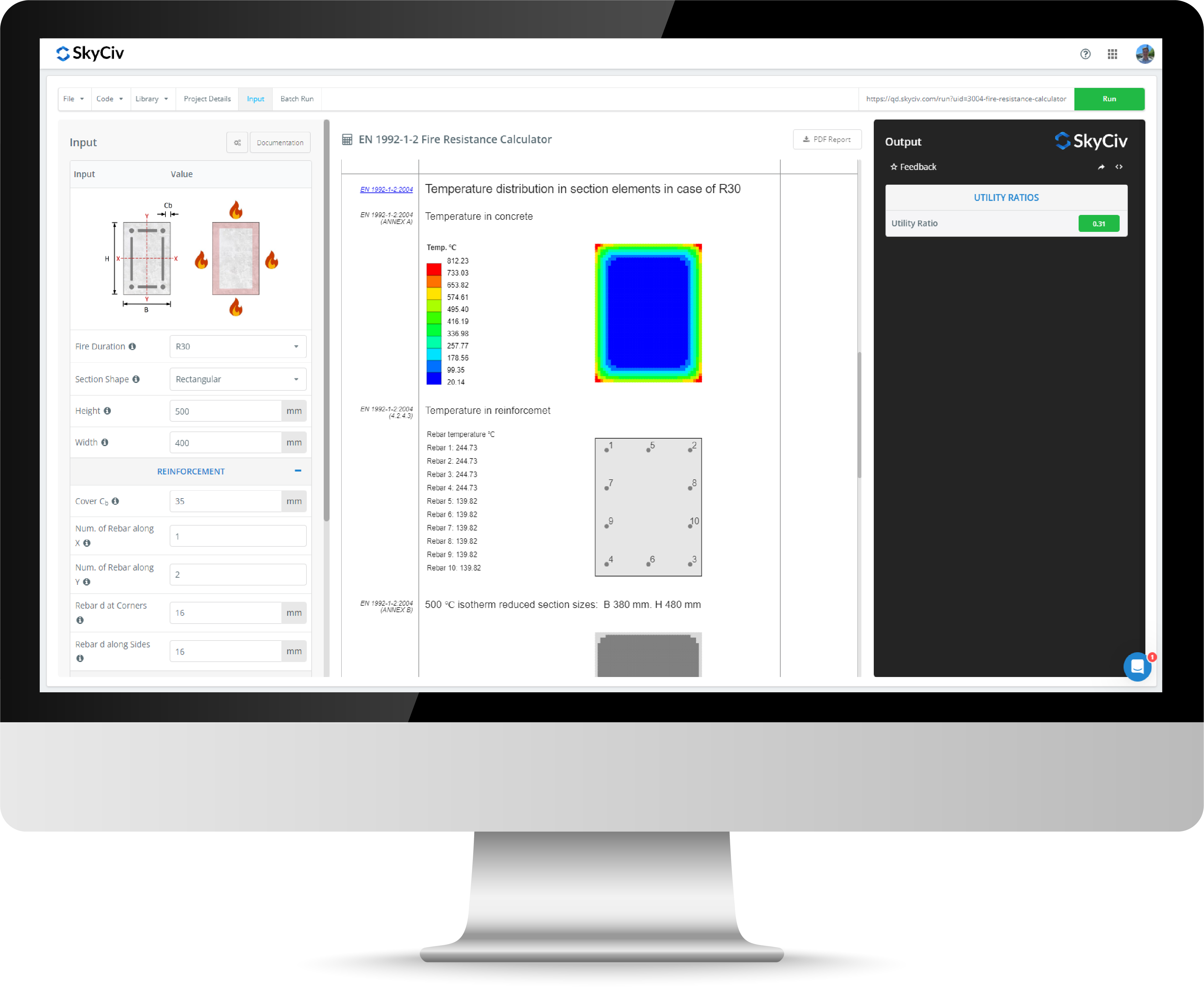Cable Sag Calculator
Ο υπολογιστής SkyCiv Cable Sag (ή Υπολογιστής εκτροπής καλωδίου) σας βοηθά να προσδιορίσετε τις δυνάμεις προέντασης που απαιτούνται για να φτάσετε σε ένα συγκεκριμένο βύθισμα καλωδίου δεδομένης μιας συγκεκριμένης διάταξης καλωδίου. Αυτή η αριθμομηχανή χρησιμοποιεί την ισχυρή τεχνολογία FEA της SkyCiv για επαναληπτική εργασία μέσω διαφορετικών δυνάμεων προέντασης για τον προσδιορισμό της απαιτούμενης δύναμης για μια συγκεκριμένη πτώση ή εκτροπή καλωδίου.
Η τελική πτώση καλωδίου και η απαιτούμενη προένταση υπολογίζονται στις ακόλουθες εισόδους:
- Μήκος καλωδίου (Μ)
- Διάμετρος καλωδίου (χιλ)
- Target Cable Sag (χιλ) - την επιθυμητή πτώση καλωδίου για την οποία επαναλαμβάνετε
- Ιδιότητες υλικού - όπως η πυκνότητα του χάλυβα και ο συντελεστής Young
- Ρυθμίσεις επανάληψης - δεκαδικά ψηφία ή ακρίβεια κατά την επανάληψη για επίλυση
Οι παρακάτω υπολογισμοί βύθισης καλωδίου βασίζονται στην επανάληψη μεταξύ διαφορετικών φορτίων προέντασης για τον υπολογισμό της επιθυμητής πτώσης καλωδίου.
Ένας οδηγός για την εκτροπή καλωδίου ή την κάμψη καλωδίου
Τι είναι το Cable Sag?
Η πτώση καλωδίου είναι η ποσότητα της παραμόρφωσης που υφίσταται ένα καλώδιο υπό το βάρος του και τυχόν φορτία προέντασης στο καλώδιο. Το βάρος του καλωδίου θα προκαλέσει κατακόρυφη πτώση:

Ωστόσο, αυτή η πτώση μπορεί να αντισταθμιστεί με την εισαγωγή μιας δύναμης τάσης στο καλώδιο, γνωστό και ως φορτίο προέντασης:

Cable Sag Equation
Η παραπάνω αριθμομηχανή θα επαναλάβει την αύξηση/μείωση της ποσότητας προέντασης στο καλώδιο για να προσπαθήσει να υπολογίσει το Target Cable Sag. Η αριθμομηχανή χρησιμοποιεί τον επιλύτη FEA του SkyCiv για να υπολογίσει με ακρίβεια αυτές τις τιμές για πιο ακριβή σχεδιασμό. Ωστόσο, απλοί υπολογισμοί μπορούν επίσης να γίνουν για τον υπολογισμό της εκτροπής ενός καλωδίου χρησιμοποιώντας απλές εξισώσεις εκτροπής καλωδίου:
Sag = (β * (L/2)²) / (2 * Τ)
όπου;
w = βάρος καλωδίου σε N/m
L = Μήκος καλωδίου
T = Εφαρμοσμένη δύναμη τάνυσης στο καλώδιο
Παράδειγμα του τρόπου υπολογισμού της πτώσης σε ένα καλώδιο
Ερ: Ας θεωρήσουμε ότι έχουμε ένα καλώδιο μήκους L=10m, αναρτάται ανάμεσα σε δύο στηρίγματα στο ίδιο ύψος. Το καλώδιο έχει ομοιόμορφο βάρος 𝑤 =0,154 kg/m, και είναι προεντεταμένο με οριζόντια τάση 𝑇 = 500N.
1. Προσδιορίστε το βάρος ανά μονάδα μήκους σε Newton:
Βάρος ανά μονάδα μήκους: 0.154 kg/m * 9.81 m/s² = 1.54 N/m
2. Χρησιμοποιήστε την παραβολική προσέγγιση για sag:
Η χαλάρωση (και) στο μέσο του ανοίγματος (x = L/2) μπορεί να υπολογιστεί χρησιμοποιώντας τον τύπο:
y = (β * (L/2)²) / (2 * Τ)
y =(1.54 N/m * (5Μ)²) / (2 * 500 Ν)
y ≈ 0.0385 m = 38,5 mm
Συγκρίνοντας τους υπολογισμούς Cable Sag FEA με τον τύπο Cable Sag
Σε σύγκριση με το αποτέλεσμα της αριθμομηχανής μας, χρησιμοποιώντας την ίδια είσοδο, μπορούμε να δούμε ότι φτάνουμε σε ένα παρόμοιο αποτέλεσμα. Στην αριθμομηχανή, μια δύναμη 342N οδήγησε σε καθαρή πτώση 38,2 mm, ωστόσο στον απλοποιημένο τύπο έχουμε δύναμη 500N για να πετύχουμε παρόμοια πτώση 38,5mm. Η παραπάνω αριθμομηχανή εκτροπής καλωδίου χρησιμοποιεί την ανάλυση πεπερασμένων στοιχείων για τον υπολογισμό του αποτελέσματος, το οποίο είναι πολύ πιο ακριβές καθώς εκτελεί μια μη γραμμική ανάλυση αντί να βασίζεται σε απλοποιημένο εμπειρικό τύπο όπως το παραπάνω παράδειγμα.

Τα αποτελέσματα είναι σαφώς παρόμοια και εντός λογικού εύρους, αλλά συνιστάται ιδιαίτερα η χρήση ενός πιο προηγμένου εργαλείου στην περίπτωση δομικού σχεδιασμού.
Γιατί πρέπει να υπολογίσουμε την πτώση σε ένα καλώδιο?
Η πτώση καλωδίου είναι ένα σημαντικό μέρος του σχεδιασμού και της εγκατάστασης οποιουδήποτε συστήματος καλωδίων. Για σχεδιασμό, Είναι σημαντικό να διασφαλιστεί η απόσταση και η διαχείριση του φορτίου στις δομές στήριξης. Για παράδειγμα, σε ηλεκτροφόρα καλώδια, ένας μηχανικός μπορεί να χρειαστεί να βεβαιωθεί ότι υπάρχει αρκετή απόσταση από το έδαφος για λόγους ασφαλείας. Επιπροσθέτως, θα πρέπει επίσης να γνωρίζουν πόσο επιπλέον φορτίο θα ασκήσει αυτό στον στύλο.
Άλλες περιπτώσεις περιλαμβάνουν γέφυρες (ιδιαίτερα κρεμαστές γέφυρες) και τα συστήματα αλυσίδων σε σιδηροδρομικές κατασκευές - όπου το εναέριο σύστημα καλωδίων θα πρέπει να στηριχθεί σε μια δεδομένη κλίση.
Η χαλάρωση ενός καλωδίου είναι επίσης απαραίτητη κατά το στάδιο της εγκατάστασης. Είναι σημαντικό για τον τεχνικό εγκατάστασης να γνωρίζει τη σωστή ένταση που πρέπει να εφαρμοστεί σε ένα καλώδιο για να έχει μια δεδομένη πτώση. Αυτό θα πρέπει επίσης να λαμβάνει υπόψη περιβαλλοντικούς παράγοντες όπως οι αλλαγές θερμοκρασίας, φορτία ανέμου που μπορεί να προκαλέσουν επιπτώσεις στη δομή στήριξης και ως εκ τούτου στο καλώδιο, και τυχόν φορτία πάγου που μπορεί να εφαρμοστούν στο καλώδιο.
Άλλοι αριθμομηχανές
Σχετικά με το SkyCiv
Εκτός από αυτή την αριθμομηχανή τάνυσης καλωδίου, η SkyCiv προσφέρει μια ευρεία γκάμα Λογισμικό δομικής ανάλυσης και σχεδίασης Cloud για μηχανικούς. Ως μια συνεχώς εξελισσόμενη εταιρεία τεχνολογίας, δεσμευόμαστε να καινοτομούμε και να προκαλούμε υπάρχουσες ροές εργασίας για να εξοικονομήσουμε χρόνο στους μηχανικούς στις διαδικασίες εργασίας και τα σχέδιά τους.
Συχνές ερωτήσεις?
Τι γίνεται αν χρειαστεί να υπολογίσω πιο σύνθετα καλωδιακά συστήματα?
Το SkyCiv διαθέτει ένα λογισμικό δομικής ανάλυσης με πλήρη χαρακτηριστικά που ονομάζεται SkyCiv Structural 3D, που υποστηρίζει την ανάλυση καλωδίων αλυσοειδών. Πρόκειται για δομικά στοιχεία που είναι μη γραμμικά και εφελκυσμένα μόνο με μεγάλες μετατοπίσεις. Έχουν μηδενική ικανότητα για δυνάμεις κάμψης ή διάτμησης, αλλά ικανό να μεταφέρει φορτίο υπό τάση.
Μπορείτε να μοντελοποιήσετε και να λύσετε σχεδόν οποιοδήποτε σύστημα καλωδίων σε 3D, καθώς εκτελούμε ένα πλήρες FEA στο σύστημα, ενώ αυτή η αριθμομηχανή εκτελεί περισσότερο μια απλή ανάλυση περιπτώσεων. Ακολουθεί ένα παράδειγμα δομής καλωδίου στο SkyCiv Structural 3D. Μάθετε περισσότερα στο Καλώδια σε SkyCiv Structural 3D.




